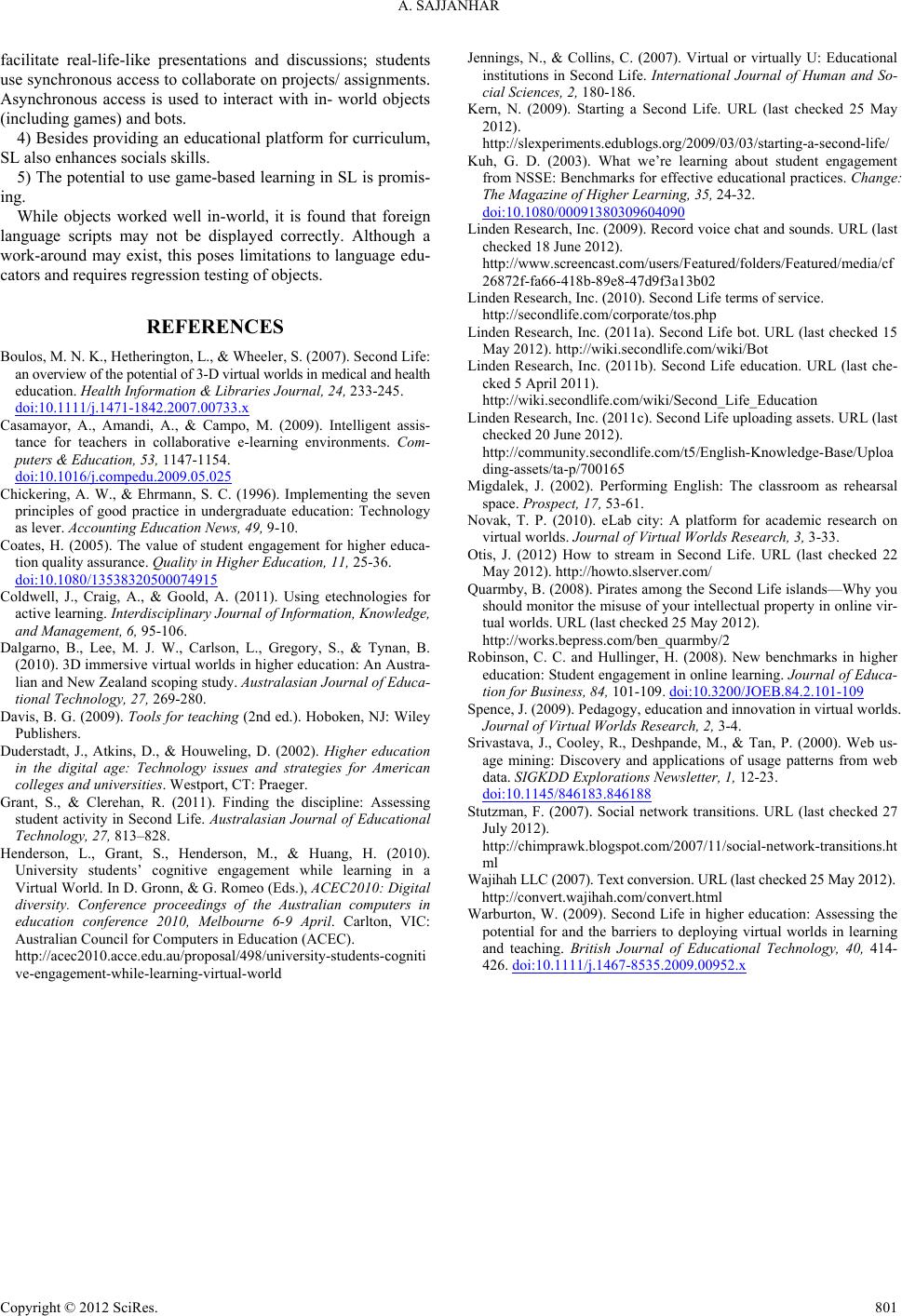
A. SAJJANHAR
Copyright © 2012 SciRes. 801
facilitate real-life-like presentations and discussions; students
use synchronous access to collaborate on projects/ assignments.
Asynchronous access is used to interact with in- world objects
(including games) and bots.
4) Besides providing an educational platform for curriculum,
SL also enhances social s skills.
5) The potential to use game-based learning in SL is promis-
ing.
While objects worked well in-world, it is found that foreign
language scripts may not be displayed correctly. Although a
work-around may exist, this poses limitations to language edu-
cators and requires regression testing of objects.
REFERENCES
Boulos, M. N. K., Hetherington, L., & Wheeler, S. (2007). Second Life:
an overview of the potential of 3-D virtual worlds in medical and health
education. Health Information & Libraries Journal, 24, 233-245.
doi:10.1111/j.1471-1842.2007.00733.x
Casamayor, A., Amandi, A., & Campo, M. (2009). Intelligent assis-
tance for teachers in collaborative e-learning environments. Com-
puters & Education, 53, 1147-1154.
doi:10.1016/j.compedu.2009.05.025
Chickering, A. W., & Ehrmann, S. C. (1996). Implementing the seven
principles of good practice in undergraduate education: Technology
as lever. Accounting Education News, 49, 9-10.
Coates, H. (2005). The value of student engagement for higher educa-
tion quality assurance. Quality in Higher Education, 11, 25-36.
doi:10.1080/13538320500074915
Coldwell, J., Craig, A., & Goold, A. (2011). Using etechnologies for
active learning. Interdisciplinary Journal of Information, Knowledge,
and Management, 6 , 95-106.
Dalgarno, B., Lee, M. J. W., Carlson, L., Gregory, S., & Tynan, B.
(2010). 3D immersive virtual worlds in higher education: An Austra-
lian and New Zealand scoping study. Australasian Journal of Educa-
tional Technology, 27, 269-280.
Davis, B. G. (2009). Tools for teaching (2nd ed.). Hoboken, NJ: Wiley
Publishers.
Duderstadt, J., Atkins, D., & Houweling, D. (2002). Higher education
in the digital age: Technology issues and strategies for American
colleges and universities. Westp ort, CT: Praeger.
Grant, S., & Clerehan, R. (2011). Finding the discipline: Assessing
student activity in Second Life. Australasian Journal of Educational
Technology, 27, 813–828.
Henderson, L., Grant, S., Henderson, M., & Huang, H. (2010).
University students’ cognitive engagement while learning in a
Virtual World. In D. Gronn, & G. Romeo (Eds.), ACEC2010: Digital
diversity. Conference proceedings of the Australian computers in
education conference 2010, Melbourne 6-9 April. Carlton, VIC:
Australian Council for Computers in Education (ACE C).
http://acec2010.acce.edu.au/proposal/498/university-students-cogniti
ve-engagement-while-learning-virtual-world
Jennings, N., & Collins, C. (2007). Virtual or virtually U: Educational
institutions in Second Life. International Journal of Human and So-
cial Sciences, 2, 180-186.
Kern, N. (2009). Starting a Second Life. URL (last checked 25 May
2012).
http://slexperiments.edublogs.org/2009/03/03/starting-a-second-life/
Kuh, G. D. (2003). What we’re learning about student engagement
from NSSE: Benchmarks for effective educational practices. Change:
The Magazine of Higher Learning, 35, 24-32.
doi:10.1080/00091380309604090
Linden Research, Inc. (2009). Record voice chat and sounds. URL (last
checked 18 June 2012).
http://www.screencast.com/users/Featured/folders/Featured/media/cf
26872f-fa66-418b-89e8-47d9f3a13b02
Linden Research, Inc. (2010). Second Life terms of service.
http://secondlife.com/corporate/tos.php
Linden Research, Inc. (2011a). Second Life bot. URL (last checked 15
May 2012). http://wiki.second life.com/wiki/Bot
Linden Research, Inc. (2011b). Second Life education. URL (last che-
cked 5 April 2011).
http://wiki.secondlife.com/wiki/Second_Life_Education
Linden Research, Inc. (2011c). Second Life uploading assets. URL (last
checked 20 June 2012).
http://community.secondlife.com/t5/English-Knowledge-Base/Uploa
ding-assets/ta-p/700165
Migdalek, J. (2002). Performing English: The classroom as rehearsal
space. Prospect, 17, 53-61.
Novak, T. P. (2010). eLab city: A platform for academic research on
virtual worlds. Journal of Virtual Worlds Research, 3, 3-33.
Otis, J. (2012) How to stream in Second Life. URL (last checked 22
May 2012). http://howto.slserver.com/
Quarmby, B. (2008). Pirates among the Second Life islands—Why you
should monitor the misuse of your intellectual property in online vir-
tual worlds. URL (last checked 25 May 2012).
http://works.bepress.com/ben_quarmby/2
Robinson, C. C. and Hullinger, H. (2008). New benchmarks in higher
education: Student engagement in online learning. Journal of Educa-
tion for Business, 84, 101-109. doi:10.3200/JOEB.84.2.101-109
Spence, J. (2009). Pedagogy, education and innovation in vir t ual worlds.
Journal of Virtual Worlds Research, 2, 3-4.
Srivastava, J., Cooley, R., Deshpande, M., & Tan, P. (2000). Web us-
age mining: Discovery and applications of usage patterns from web
data. SIGKDD Explorations Newsletter, 1, 12-23.
doi:10.1145/846183.846188
Stutzman, F. (2007). Social network transitions. URL (last checked 27
July 2012).
http://chimprawk.blogspot.com/2007/11/social-network-transitions.ht
ml
Wajihah LLC (2007). Text conversion. URL (last checked 25 May 2012).
http://convert.wajihah.com/convert.html
Warburton, W. (2009). Second Life in higher education: Assessing the
potential for and the barriers to deploying virtual worlds in learning
and teaching. British Journal of Educational Technology, 40, 414-
426. doi:10.1111/j.1467-8535.2009.00952.x